JAPANESE CLOTHES

Edo inbairo There are four main types of clothing found in Japan: 1) those worn for everyday use: 2) those worn for special occasions such as festivals; 3) work clothes; and 4) costumes worn for noh and kabuki theater. Materials used in making clothes include linen, silk and cotton. Bright colors have traditionally been associated with young people while dark colors have been associated with older people.
The Japanese, especially Japanese women, are very well dressed. Their traditional clothes are elegant and refined and they like high quality, top European-designer stuff.
Japanese tend to dress more formally than Westerners. They are less likely to wear jeans and running shoes in an office, or shorts or bright-colored clothes in the streets. You also don't see as many middle-aged Japanese dressing like hip teenagers as you do in the United States.
Even the prime minister sometimes saunters around in a uniform that looks like something a gas station attendant would wear.
Good Websites and Sources: Good Photos at Japan-Photo Archive japan-photo.de ; Japanese Kimono.com japanesekimono.com ; Short Piece on the Clothes of Japan adrianaallen.com/blog ; Japan -Shop.com japan-shop.com ; Men’s Online Conversion of Japanese, European and American Sizes onlineconversion.com ; Women’s Online Conversion of Japanese, European and American Sizes onlineconversion.com ; Museums and History Japan Costume Museum iz2.or.jp/english ; Historical Clothing yusoku.com/english ; Tokyo National Museum site tnm.go.jp ; Kyoto National Museum kyohaku.go.jp ; Bunka Gakuen Costume Museum bunka.ac.jp ; Sengoku Daimyo sengokudaimyo.co Links in this Website: JAPANESE SILK Factsanddetails.com/Japan ; KIMONOS AND JAPAN Factsanddetails.com/Japan ; FASHION IN JAPAN Factsanddetails.com/Japan
History of Textiles in Japan
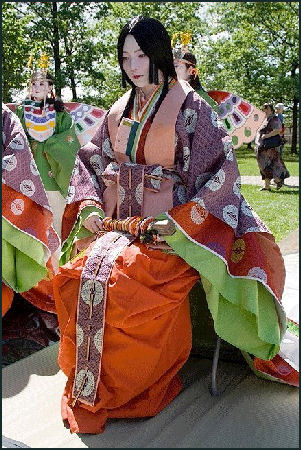
10th century clothes Until the 16th century, garments were made mostly of plant fibers or silk. The materials from which clothes were made were often an indication of social status. Linen is the oldest known material used in Japan. In the old days flax was grown and woven by most families. Straw raincoats and sandals were used for hundreds of years. Clothes worn by emperors and sumo wrestlers used to be made of hemp.
Among the 7th century Shoso-in treasures in Nara are a pair of embroidered indoor shoes made from hemp and paper and decorated with silk and brocade. Believed to have been brought from China’s Tang Dynasty by a returning Japanese envoy, the shoes may have been worn by Empress Komyo as they were included on a list of item used by her and Emperor Shomu.
Heian period (794-1192) garments worn by nobles often had multiple layers and took many months to make. Courtiers wore “junihitoe”, which literally means 12 layers of silken robes but often included as many as 20, weighing several kilograms. Robes were often changed according to the season and latest fashions.
In the Heian Period nobles dressed in “kariginu” robes made of silk and “ebosho” brimless headgear. Wearing the kariginu straightened the posture and forced one to walk slowly, When doing something one had to use one hand to pull back the dangling sleeves. In the spring nobles wore a white, diaphanous robe over a red inner robe, or visa versa. The two styles (white over red and red over white) appeared pink, but differed slightly expressing the different shades of the color in early and late spring.
In the medieval times color was a symbol of rank as it was in some other Asian cultures: with yellow worn by people of no rank; black by servants; red by people associated with Chinese families; and green by those with ties with Korean families. Colors ranging from purple to dark green were worn by people associated with royalty.
In Japan the emphasis has usually been on the quality of fabric rather than shape of the woman. "Kimonos weren't cut, they were draped." The traditional Japanese costume had no pockets. In the old days clocks were worn on chords around the neck and tucked into the obi. “Aizome” is the traditional method of dying fabrics blue used vats filled with fermented indigo plants.
In the Edo Period , fashion trends were often set by prostitutes, courtesans and fashion-conscious women in the merchant class. The first Japanese men to wear Western-style trousers in the 1870s sometimes became so frustrated with the buttons that fastened the flies they sometimes tore off their pants in frustration while in the bathroom.

Yuzen robe
In the 1970s, the textile industry in Japan was at its peak, with revenues of ¥300 billion. By the end of the 1990s that figure had shrunk to ¥100 billion.
History of Weaving in Japan
Christal Whelan wrote in Daily Yomiuri: “In pre-modern Japan, weaving was traditionally a man's occupation although women often prepared the looms and sat above them in order to batch the pre-dyed yarns in accordance with the design. Finally, in the 19th century, when Japan energetically embarked on its course of modernization, the government sent three textile experts from Kyoto to Lyon, France, to acquire new weaving technology. They returned with the jacquard mechanism, a system that uses hundreds of punched cards to code designs and batch the threads of the handlooms. This mechanism and the subsequent introduction of powerlooms freed women from their previous role as human jacquards and allowed them to become de facto weavers. Later innovation would replace the old punch-card system with a computerized jacquard using floppy disks.[Source: Christal Whelan, Daily Yomiuri, May 8, 2011]
“These technological innovations radically transformed the weaving industry of Nishijin from single-weaver households to a household production system in which whole families worked at home on looms either owned by the weaver or rented from the manufacturer. In both cases, although the weavers worked at home, manufacturers provided them with the raw materials and paid them by the piece. Small factories or workshops away from the home eventually developed in Nishijin in the postwar years with 10 to 20 weavers employed from nine to five and paid at an hourly rate.”
“In spite of the increasing workforce, the industry fell into decline in the 1980s with dozens of manufacturers forced to close each year and those lucky enough to survive pressed into a drastically curtailed production mode. The main reason for the decline was the accelerating shift in fashion from the ethnically defined kimono to ready-to-wear clothing and the dawning awareness of global designer labels. Manufacturers initially responded to the disappearing market by outsourcing. First they hired weavers in the Tango Peninsula, about 100 kilometers from Kyoto. Once known for its silk crepe, that industry had become depressed and weavers were eager for new work. Manufacturers went further still and contracted weavers in China, Korea and Taiwan.”
7th Century Tie-Died Garment
The Hanada Kokechi no Nuno no Ho is a piece of tie-dyed linen outerwear with a blue and red checkered design from the 7th century in the Shoso-in collection in Nara. The red color has long faded away. According to recent research, the safflower plant was used for the red dye. Designer Kansai Yamamoto told the Yomiuri Shimbun , “Though it is now faded, vivid and very conspicuous colors were used in the garment. The outerwear is just like one piece in my collection. I'd like to feel the cloth in my hand and actually wear this. [Source: Yomiuri Shimbun, November 3, 2011]
When people wear beautiful colors, they straighten and brighten up. I heard there's a theory this type of garment served as work clothes worn by government officials.The streets during the Tempyo era (729-749) must have been vibrant with people leisurely walking around in this garment.The clothing conveys the designer's glowing appeal, which still holds up 1,250 years later. This garment has the kind of power you don't see in clothes in modern Japan, where only items similar to each other stay popular.
Silk
See Separate Article
Kimonos
See Separate Article
Yukatas
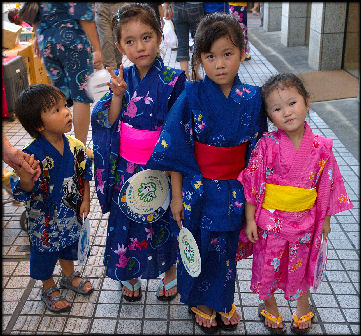
kids in yukatas The yukata is a light kimono designed for outdoor summer use or indoor casual wear like a bathrobe. Used by both men and women, it is commonly worn around the house by women and used by customers at ryoken (traditional inns) and onsens (hot springs). They are usually made of cotton, which is comfortable and absorbs perspiration after bathing. A Tanzen is a heavier outer garment worn over a yukata.
The yukata evolved from the yukatabira, a bathrobe that dates back to the Heian period (794 to 1185). It was regarded as everyday wear in the 19th century. In recent times it has become very popular to wear yukata during summer festivals and firework shows,
Yukatas are very cool and comfortable. A good quality one purchased in a department stores goes for around $250. Traditional yukatas have an indigo background and white print patterns and designs or a white background and indigo designs. Traditionally the patterns were made with fermented indigo with the darkness being determined by the number of times the garment was placed in dye baths. Modern ones often feature bright colors. A yukata obi (a “han-haba”) is about half the width of regular kimono obi
Men's Clothes in Japan
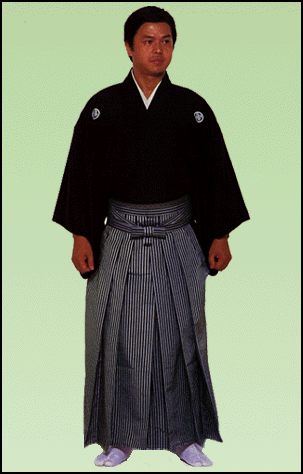
male kimono Some Japanese men are quite fashionable, wearing nicely cut suits and designed clothes, or sport nice-looking, casual sports clothes. Other, though, dress pretty nerdy. They sometimes wear dark socks with Bermuda shorts, white socks with suits and have pens and calculators bulging from their pockets. But they are not as bad as they used to be.
The traditional black robe worn by men is called a kimono. Usually worn at ceremonial occasions such as weddings or a New Year's gatherings, it is consists mainly of a coatlike “haori” and pleated skirt-like pants (“hakamas”) One male kimono looks pretty much like another. They cost around $2,000 to $10,000 buy and can be rented for about $400 a day.
Christal Whelan wrote in Daily Yomiuri: “Men's obi had hardly evolved since the end of the 15th century when the kimono's prototype — the kosode — became the standard dress for both men and women. Men's obi, lacking in diversity and ornament, remained rudimentary. Fashioned from white, grey or black-hued silk, never more than 9 centimeters wide, men tied this sash in a simple half bow at the back or tucked it in at the waist.”
In the old days, kimonos were sometimes worn with vestlike “kamishimos” (the traditional garments of samurai) and special underwear made of loose crepe cotton that lets cool air circulate around the body. Kimonos today are usually worn with button up socks and sandals. The main problem with wearing a male kimono is that the whole thing has to be taken off when going to the bathroom.
The Kariyushi is an Okinawan-style shirt, It has no collar and has patterns and stripes running from the shoulder to the bottom of the shirt on one side. It is not tucked in.
Men in Women's Clothes in Japan
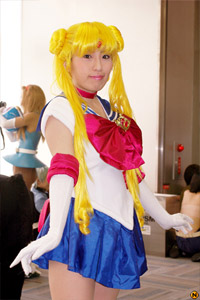
Sailor Moon Japanese men sometimes wear fashions usually associated with women: belly-button-exposing, mini-T-shirts, tight shorts, and cute accessaries. Some even wear feminine style sandals and purses to match their lipstick.
An editor at the men's magazine Brutis told the International Herald Tribune, "Boys are actually shopping in girl's boutiques for smaller size pants and bring colors. Sharing clothes with their girlfriends is prerequisite of any relationship."
The trendy brand 20471120 has introduced a line of mini skirts for men that are designed to be worn over pants and are available in 100 colors. One man who wore a skirt while his wife wore faded jeans told the International Herald Tribune that before they got married, "Our first fight was over who should wear the wedding dress."
Role models for young men include pretty boy singers like Smap and Kinki Kids and glam rock stars like Izam who appear on stage in platform shoes, sequined tights, carrying a teddy bear.
In fashionable Harajuku district is become increasingly common to see men in skirts and skirt-like garments. Naihiri Yamamoto of ZOOEE, an apparel company that makes men’s skirts told Kyodo News, “Men wear a skirts just because they think they look cool. Fashion-conscious guys have tried everything else they can in men’s style, and the skirt is appealing as something new.” Hisaki Oshima, a 51-year-old father of two, has been wearing skirts for several years. In his blog he offers advise on things like to deal with leg hair.
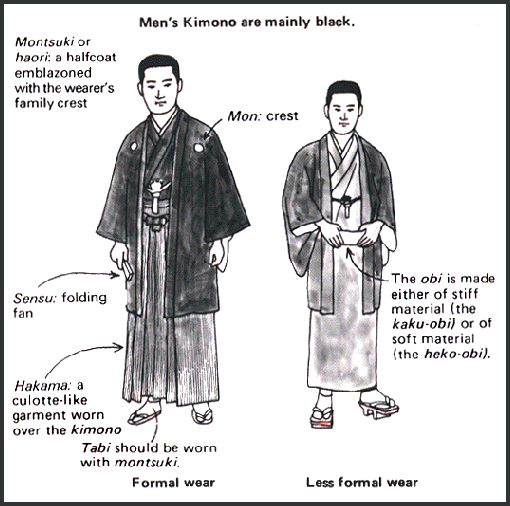
Men’s Handbags and Jewelry in Japan
Many men carry purse-like handbags. Some regard them as symbols of their success and spend quite a bit of money on them. Gucci, Burberry, Louis Vuitton and other companies have introduced men’s handbags aimed specifically for the Asian market.
The owner of man’s purse, a 25-year-old construction manager, told the International Herald Tribune: “It’s perfect when I’m not carrying too much stuff. I have a lot of bags, but this one is the most convenient. You don’t have to dig around — just open it up and everything is right there. A 31-year-old man said, “It’s comfortable. I can fit everything I need in here, and I know I won’t lose things.”
More and more men are wearing diamond jewelry and accessories
Uniforms in Japan
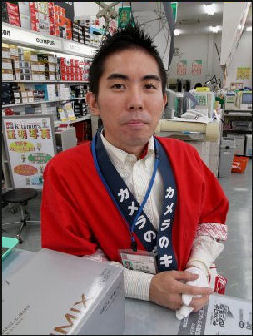
Retail hopi The Japanese are big on uniforms. They are worn by workers of all sorts of different occupations, from office ladies and department store workers to machinists and engineers. They are useful in saving money on clothes and helping customers identify workers. Some people complain that uniforms promote rigidity and stifle individuality.
Even the prime minister sometimes saunters around in a uniform that looks like something a gas station attendant would wear.
Carpenters and construction workers in Japan often wear a strange get up consisting of super baggy parachute-style pants tied at the ankles and mitten-like shoes that fit separately around the big toe and other toes and look like something a scuba diver would wear.
Workers often wear a “hopi”, a short blue cotton jacket with an insignia of the workers trade or company. It has traditionally been worn with short tight cotton pants called “momohiki”.
Many Japanese workers wear a suit for the commute to their job site and then change into a company uniform more practical for doing physical work or working in a workshop or laboratory.
Geta and Other Kinds of Japanese Footwear
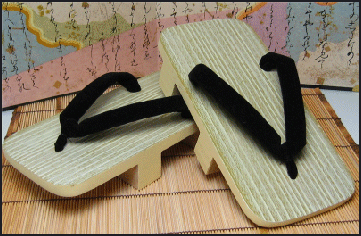
Geta The traditional Japanese sandals worn with kimonos are called “geta”. Classic geta look like flip flops supported by two audio-cassette-size platforms. They were originally designed like that so the foot would elevated in muddy streets and prevent the feet from getting dirty. Geta can be worn indoors on wooden floors, but never on tatami mats.
Geta-like sandals have been around for a long time. They have been discovered in the coffins of Egyptian pharaohs and are believed to have arrived in Japan from Southeast Asia. During the Yayoi period (300 B.C. to A.D. 300) they were worn by farmers. In the Kofun period (A.D. 300 to 700) they became widely used by people from all walks of life. During the Edo period (1603-1868) they became fashion statements and were lacquered and decorated with velvet and silk.
With industrialization they became mass produced. More than 55 million were produced annually in the 1950s. Due to changing lifestyles and competition from China, the geta industry is now only a shadow of what it once was. These days only around 5 million are produced domestically each year.
Among the 7th century Shoso-in treasures in Nara are a pair of embroidered indoor shoes made from hemp and paper and decorated with silk and brocade. Believed to have been brought from China’s Tang Dynasty by a returning Japanese envoy, the shoes may have been worn by Empress Komyo as they were included on a list of item used by her and Emperor Shomu.
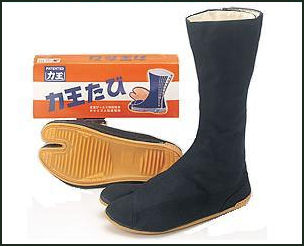
carpenter footware Traditional Japanese shoe shops can make a pair of custom made geta on the spot. The wooden base is usually made of paulownia. The proper fit is usually worked out by loosening or tightening the straps, prices range from $50 to $500.
“Zoris” (flip flops) were invented by Japanese. Traditionally they have had flat soles made of straw, rush, bamboo, cork or rubber, covered with leather. “Tabil” are socks that button up the sides and fit separately around the big toe and the four other toes. They are designed that way to be worn with sandals.
Crocs were redesigned for Japanese market after a series of accidents in which the shoes got caught in escalators. The new shoes have a harder and thicker sole and toe area and have been coated with silicone. As of September 2007 there were 40 cases of people wearing Crocs or imitation Crocs getting their shoes stick in escalators. Some people suffered minor injuries. A five-year-old girl broke her toe. There were calls to have the shoes banned.
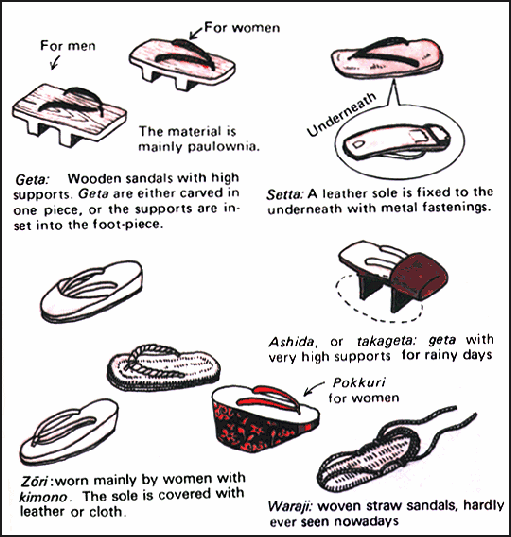
The Nara-based company Okamoto Corp has developed an odorless “no-sweat” sock that owner of the company claims can be worn for a week in the middle of summer without producing any smells. Introduced in 2004, the sock sell for between $8 and $18 a pair.
Traditional Japanese Accessories
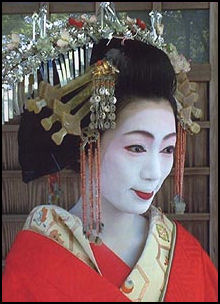
hair pieces worn by modern courtesan Skilled craftsmen still make traditional adornments the traditional way. “Tsumami-kamzashi” are hair decoration made in shape of flowers from silk. In the Edo period they were widely worn by unmarried women but today are mainly just worn by maikos (geisha apprentices) and girls in coming of age ceremonies.. They are made by pinching pieces of silk into the shape of flowers and then glueing them together to make artificial flowers. Tsumami means “pinching.”
Tortoise shell has traditionally been used to make brooches, hairpieces and other accessories. The yellow-colored plastron and back-and-brown-spotted carapace from shell from endangered hawksbill turtles is highly prized and has been dubbed the “jewel of the sea.” Tortoise shell craftsmen use a heated iron to bend and shape the shell and stick pieces together. If too much heat is applied the shell will char. If not enough is applies the pieces will come apart easily.
Tortoise shell art is believed to have originated in China more than 2,000 year and was used in making the crown of Chinese Emperor Qin Shi Huangdi. In Japan , the industry has been centered in Nagasaki where hawksbill turtles were brought in by foreign traders. A craftsman at a tortoiseshell workshop that was established in 1709, told the Daily Yomiuri,, “People are attracted to tortoiseshell products because of their luster and their colors, which are peculiar to natural materials. Since each pattern is different, people can feel satisfaction by possessing something that is truly unique.”
See Separate Articles: ENDANGERED SEA TURTLES ioa.factsanddetails.com HAWKSBILL SEA TURTLES ioa.factsanddetails.com
Headband with slogans and rising suns tied around the head are called “konjo” (“guts”). They were popular with members of some rock groups in the 1970s and 80s and are worn by Japanese at sporting events, festivals and rallies.
Casual Clothing in Japan

woman on the streets Dress-down Friday was practiced by many companies for a while but is now largely a thing of the past. One political analyst told the Los Angeles Times, “The idea was it was suppose to relax you. But instead everybody got stressed out wondering what to wear.” Many people ended looking quite silly.
In 2005 the Koizumi government sponsored a “Cool Biz” campaign to encourage men to shed their suits and wear more comfortable and lightweight clothing in the summer to get people to use less air conditioning and save energy. Koizumi himself shed his tie and dressed in Okinawan shirts.
“Cool Biz brought back memories of a similar “e-cool” campaign in the mid 1990s by Prime Minister Tsutomi Hata who unsuccessfully tried to convince the nation’s men to were a bizarre and hideous looking safari jackets made from a light material with strange sleeves that stopped at the elbow. He lasted only 64 days in office.
Hawaiian shirts on working salarymen became a not uncommon sight in Tokyo during the summer 2011 Super Cool-Biz, energy-saving campaign that encouraged people to use less air conditioning in the wake of the Fukushima nuclear power plant crisis.
Japanese blue jeans sell well in Asia because they fit Asian bodies better than jeans made by Western companies.
Some clothing makers, stores and department stores accept recycled clothes. Uniqlo accept used Uniqlo products.
Image Sources: 1) 3) National Museum in Kyoto 2) 12) Liza Dalby's Genji website 4) 8) 13) Ray Kinnane 5) MIT Education 6) Japan Zone 7) 11) illustrations JNTO 9) 10) Gods from Japan
Text Sources: New York Times, Washington Post, Los Angeles Times, Daily Yomiuri, Times of London, Japan National Tourist Organization (JNTO), National Geographic, The New Yorker, Time, Newsweek, Reuters, AP, Lonely Planet Guides, Compton’s Encyclopedia and various books and other publications.
Last updated April 2012
